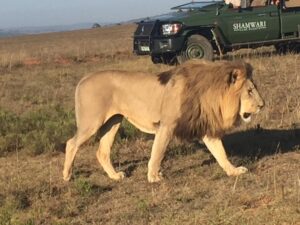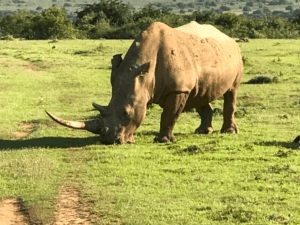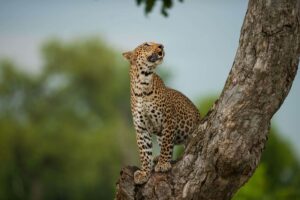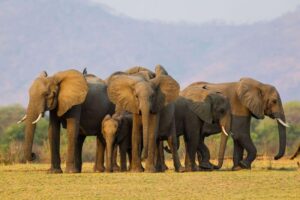For many travellers, the highlight of a safari isn’t just the landscapes or the excitement of spotting the Big Five—it’s the chance to see that one animal you adore.
Whether it’s the elusive leopard, a herd of elephants or playful monkeys, having a favourite can make every encounter feel even more special.
I completely understand the fascination. For me, it’s monkeys. I could watch them for hours as they play, groom, argue and go about their daily lives. Their energy and personalities never fail to captivate me.
Many of my clients have a particular animal they’re keen to see, whether it’s the majestic lion, a rare black rhino, or the sleek cheetah.
While it’s wonderful to tailor a safari to improve your chances of a sighting, it’s important to keep an open mind. Safaris are full of unexpected moments, and focusing too much on one species can mean missing out on the magic of everything else.
That said, if there’s one animal you’re dreaming of, certain destinations across Africa offer much higher chances of a sighting. Here’s a guide to where you’re most likely to find your favourites—and how to enjoy the journey while keeping your expectations in check.
Where to see Lions: Kruger National Park, South Africa

For a quintessential African safari experience, Kruger National Park in South Africa is one of the best places to see lions in the wild.
Spanning nearly 2 million hectares, Kruger is home to a large population of lions, offering an excellent opportunity to witness these majestic predators in their natural habitat.
The park’s vast, diverse ecosystems—ranging from savannahs to dense bush—provide perfect settings for lion sightings, especially during the cooler early mornings and late afternoons when lions are most active.
Kruger also offers a range of accommodation options, from luxury lodges to private game reserves, ensuring a comfortable stay amidst the wilderness.
For a more exclusive experience, consider staying in a private concession area like Sabi Sand, adjacent to Kruger, where game drives are less crowded and you can often see lions up close.
Here, the landscape of dry riverbeds and open plains creates ideal conditions for spotting lion prides as they hunt, rest or interact.
As well as lions, Kruger is home to the “Big Five,” so expect to encounter elephants, rhinos, leopards and buffalo too, making it a dream destination for wildlife lovers.
Alternatives that are great for lion spotting include Serengeti National Park, Tanzania; Masai Mara National Reserve, Kenya; Ngorongoro Crater, Tanzania and Etosha National Park, Namibia
Did you know… that female lions do most of the hunting, while males primarily protect the pride’s territory and defend against rival males?
Where to See Rhinos: Shamwari Game Reserve, South Africa

When it comes to rhino sightings, Shamwari Game Reserve in South Africa stands out as a top destination.
This private game reserve is part of the Eastern Cape’s malaria-free region, offering both a spectacular wildlife experience and an opportunity to learn about rhino conservation efforts firsthand.
Shamwari is home to both black and white rhinos, and visitors can spot them on game drives across its varied landscapes, from grasslands to dense thickets.
Shamwari is deeply committed to rhino conservation, and the reserve plays a key role in protecting these endangered species from poaching. Guided safaris provide the chance to see rhinos up close while gaining insight into the conservation challenges they face.
The reserve also offers the unique experience of participating in rhino tracking with expert guides, allowing you to observe these magnificent animals in their natural environment.
With a range of luxury accommodations and expert rangers, Shamwari provides a personalised safari experience that combines thrilling wildlife encounters with the opportunity to support rhino conservation in a meaningful way.
Alternatively, Kruger National Park, South Africa; Ngorongoro Crater, Tanzania; Black Rhino Sanctuary, Kenya and Etosha National Park, Namibia are all excellent locations for rhino.
Did you know.. that the white rhino‘s name comes from a mistranslation of the Dutch word “wijde,” meaning “wide,” referring to its broad mouth.
Early Dutch settlers in South Africa noticed that the white rhino had a much wider mouth compared to the black rhino, which has a more pointed one. They called it the “wijde” rhino, meaning “wide-mouthed.”
Over time, this was misheard as “white,” and the name stuck. Despite the name, the white rhino is grey, not white. Similarly, the black rhino got its name due to the darker colour of its mouth, not its body!
Where to See Leopards: MalaMala Game Reserve, South Africa

For some of the best leopard sightings in Africa, MalaMala Game Reserve in South Africa is a top choice.
Situated in the Sabi Sand Game Reserve, which shares an unfenced boundary with Kruger National Park, MalaMala is renowned for its leopard population. The area’s dense bushveld and riverine habitats are perfect for these elusive big cats, and the reserve is one of the best places in the world to see them in the wild.
MalaMala offers exclusive, high-quality safari experiences with expert trackers and guides who are adept at locating leopards. These skilled rangers often know the habits of individual leopards and can predict their movements, which increases the chances of sightings.
Whether it’s a solitary male lounging on a tree branch or a mother and her cubs on a kill, leopards are often spotted in this iconic safari destination.
The reserve is also home to other members of the “Big Five,” including lions and elephants, making it a must-visit for any serious wildlife enthusiast. Luxury lodges here ensure that guests experience the thrill of safari in style and comfort.
Alternatively, other locations that are good for leopard sightings include the Okavango Delta, Botswana; Serengeti National Park, Tanzania; Luangwa Valley, Zambia; and the Masai Mara National Reserve, Kenya
Did you know… that leopards are highly skilled at climbing trees, and they often drag their kills up into the branches to keep them safe from scavengers like hyenas and lions.
Where to See Elephants: Amboseli National Park, Kenya

Amboseli National Park in Kenya is famous for its large herds of elephants, making it one of the best places in Africa to see these majestic creatures.
Set against the backdrop of Mount Kilimanjaro, the park offers breathtaking views as elephants roam freely across the open plains, often within sight of the snow-capped peak.
Amboseli is particularly known for its large, well-established elephant families, and the park’s long-standing elephant research project has contributed to an intimate understanding of their behaviour and social structures.
Elephants in Amboseli are relatively habituated to vehicles, allowing for close-up encounters, particularly around the park’s water sources where herds gather to drink.
This creates excellent opportunities for photography, as elephants’ interactions with one another—whether bathing, dusting themselves, or feeding—can be witnessed at close range.
Many luxury lodges and camps in the park, such as Tortilis Camp, offer superb views of the elephants, often in the mornings and evenings when the animals are most active.
Amboseli also provides the chance to spot other wildlife, such as giraffes, zebras and wildebeests, making it an ideal safari destination for those wishing to witness elephants in one of Africa’s most iconic landscapes.
Alternatively, Chobe National Park in northern Botswana is renowned for its abundant elephant population and as it – of course – Addo Elephant National Park, South Africa. Also try the Okavango Delta, Botswana.
Did you know… that elephants can “hear” with their feet. They detect vibrations in the ground through sensitive cells in their feet, allowing them to communicate over long distances. This ability helps them sense seismic activity, like the movement or calls of other elephants, even miles away, long before they’re audible to humans.
How Do You Maximise Your Chances of a Dream Animal Sighting?
The options I’ve shared above are just the beginning.
Perhaps you’re dreaming of seeing a cheetah at full pace, chasing its prey.
Maybe you’re fascinated by the intricate social dynamics of a pack of painted wild dogs.
Are you a meerkat lover, captivated by their quirky behaviour and upright poses?
Or perhaps you’re an avid birder, eager to witness Africa’s vibrant and diverse birdlife, from kingfishers to carmine bee-eaters.
Whatever your passion, I can help you plan the perfect safari to make that dream encounter a reality.
Expert Guidance from a Safari Veteran
With 10 African trips of my own and countless safaris arranged for clients, I know exactly where to go, when to go and which lodges will give you the best chance of seeing your favourite animals.
I’ll tailor your itinerary to match your preferences and maximise your chances of those pinch-me wildlife moments.
Extraordinary Experiences That Go Beyond Sightings
But that’s not all. Thanks to my conservation connections in Africa, I can often arrange extraordinary experiences that bring you closer to the animals than you ever thought possible.
For example, I once joined a rhino darting team to help fit a tracker to its horn—a life-changing moment I’ll never forget.
Imagine having a similarly unforgettable encounter that becomes a story you’ll cherish forever.
A Free Consultation for Stress-free Planning
To get started, just drop me a line at janey@berrytravel.co.uk or give me a call on 01372 677999 to arrange a free consultation with me.
I’ll take the time to understand your goals and preferences before providing personalised recommendations.
There’s no obligation to book, but you’ll leave with a clear plan to get you closer to that incredible wildlife experience you’ve been dreaming about.
Not Read My Guide Yet?

If you’re still deciding where to go, my free guide, How to Find Your Perfect Safari, is a must-read.
In just 10 minutes, you’ll discover the key safari destinations, the best times to visit and insider tips to avoid common mistakes.
It’s packed with insights to help you feel confident in planning your dream trip. Fill in your details below to download it now!




